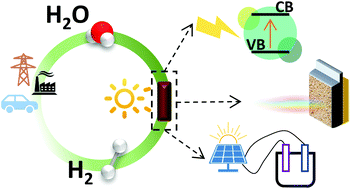Solar H2 production systems: current status and prospective applications†
Abstract
The effect of anthropological greenhouse gas (GHG) emissions on climate change is a staple of globalized civilization, which makes carbon-rich fossil fuel replacement an emergency. In this context, solar H2 plays a fundamental role as it can be easily used as a green energy vector in many applications, ranging from transportation to industry. Sun-driven water splitting devices for H2 production are a perfect example of the circular economy concept, as they use a renewable energy source to split water into H2 and O2, which in turn can be used in combustion engines, producing water as a by-product. This technology has still many limitations and needs a strong breakthrough to be considered in the market. The aim of this review is to precisely outline, from a critical point of view, the recent developments in this field. In particular, the three fundamental types of devices, i.e. photocatalytic (PC), photoelectrochemical (PEC) and photovoltaic-electrolyzer (PV-EC), are firstly described in terms of fundamental working principles. Then, a recent state-of-the-art update underlines the main progress in materials optimization and device engineering, pointing out the limitations of large-scale application of these systems. Sun-driven H2 production feasibility is regarded also from an economical point of view based on recent literature data, focusing on the future possibilities of the technology integration in the world energy supply scenario.

- This article is part of the themed collection: Green Chemistry Reviews


 Please wait while we load your content...
Please wait while we load your content...